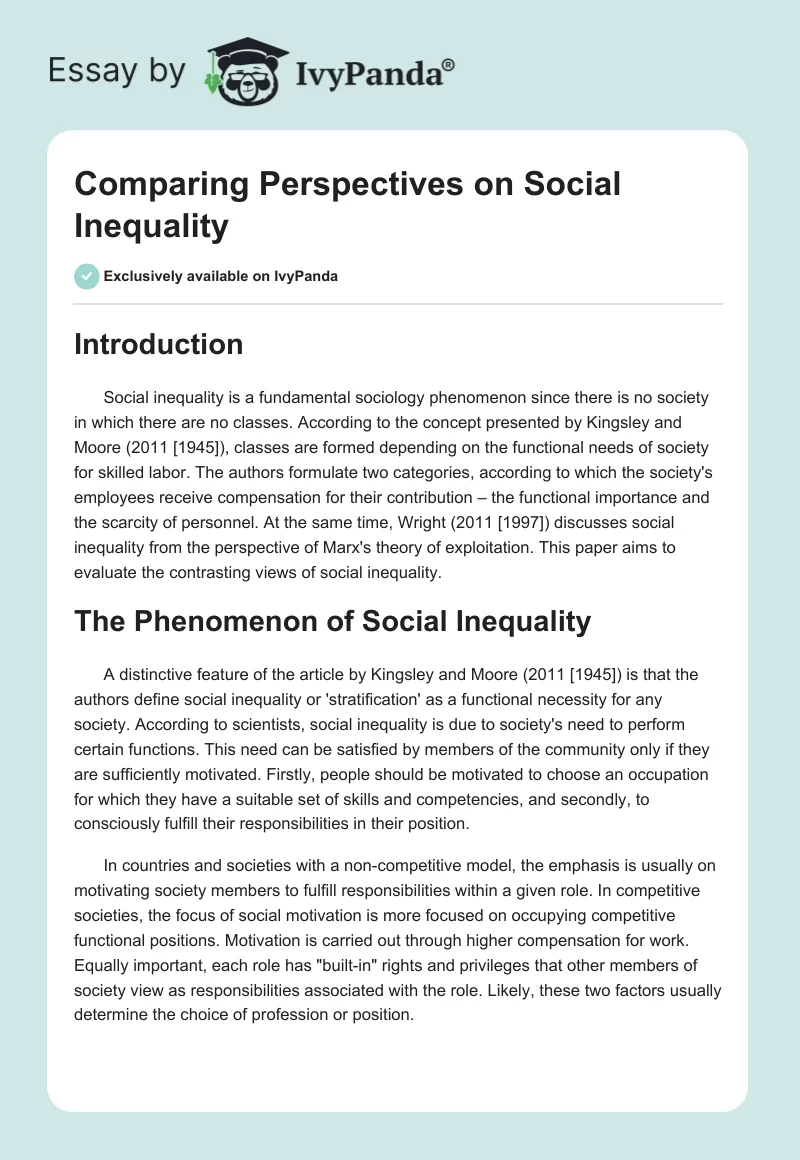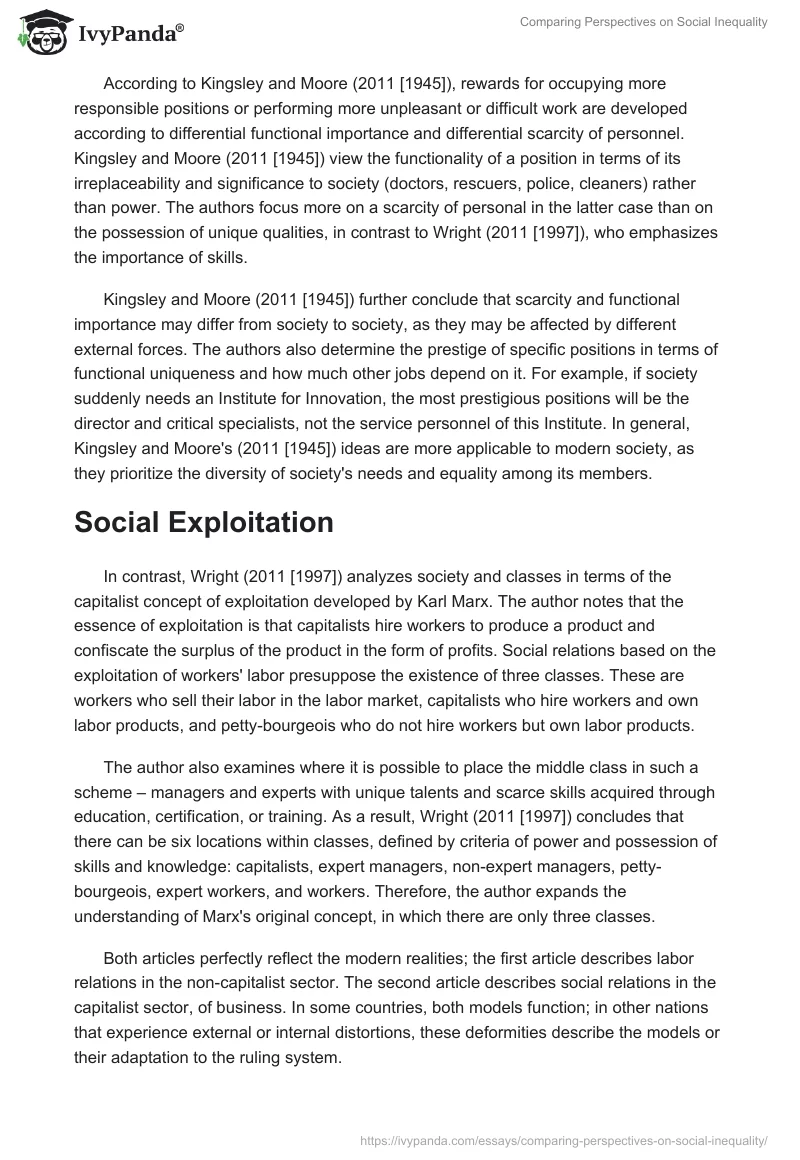Introduction
Social inequality is a fundamental sociology phenomenon since there is no society in which there are no classes. According to the concept presented by Kingsley and Moore (2011 [1945]), classes are formed depending on the functional needs of society for skilled labor. The authors formulate two categories, according to which the society’s employees receive compensation for their contribution – the functional importance and the scarcity of personnel. At the same time, Wright (2011 [1997]) discusses social inequality from the perspective of Marx’s theory of exploitation. This paper aims to evaluate the contrasting views of social inequality.
The Phenomenon of Social Inequality
A distinctive feature of the article by Kingsley and Moore (2011 [1945]) is that the authors define social inequality or ‘stratification’ as a functional necessity for any society. According to scientists, social inequality is due to society’s need to perform certain functions. This need can be satisfied by members of the community only if they are sufficiently motivated. Firstly, people should be motivated to choose an occupation for which they have a suitable set of skills and competencies, and secondly, to consciously fulfill their responsibilities in their position.
In countries and societies with a non-competitive model, the emphasis is usually on motivating society members to fulfill responsibilities within a given role. In competitive societies, the focus of social motivation is more focused on occupying competitive functional positions. Motivation is carried out through higher compensation for work. Equally important, each role has “built-in” rights and privileges that other members of society view as responsibilities associated with the role. Likely, these two factors usually determine the choice of profession or position.
According to Kingsley and Moore (2011 [1945]), rewards for occupying more responsible positions or performing more unpleasant or difficult work are developed according to differential functional importance and differential scarcity of personnel. Kingsley and Moore (2011 [1945]) view the functionality of a position in terms of its irreplaceability and significance to society (doctors, rescuers, police, cleaners) rather than power. The authors focus more on a scarcity of personal in the latter case than on the possession of unique qualities, in contrast to Wright (2011 [1997]), who emphasizes the importance of skills.
Kingsley and Moore (2011 [1945]) further conclude that scarcity and functional importance may differ from society to society, as they may be affected by different external forces. The authors also determine the prestige of specific positions in terms of functional uniqueness and how much other jobs depend on it. For example, if society suddenly needs an Institute for Innovation, the most prestigious positions will be the director and critical specialists, not the service personnel of this Institute. In general, Kingsley and Moore’s (2011 [1945]) ideas are more applicable to modern society, as they prioritize the diversity of society’s needs and equality among its members.
Social Exploitation
In contrast, Wright (2011 [1997]) analyzes society and classes in terms of the capitalist concept of exploitation developed by Karl Marx. The author notes that the essence of exploitation is that capitalists hire workers to produce a product and confiscate the surplus of the product in the form of profits. Social relations based on the exploitation of workers’ labor presuppose the existence of three classes. These are workers who sell their labor in the labor market, capitalists who hire workers and own labor products, and petty-bourgeois who do not hire workers but own labor products.
The author also examines where it is possible to place the middle class in such a scheme – managers and experts with unique talents and scarce skills acquired through education, certification, or training. As a result, Wright (2011 [1997]) concludes that there can be six locations within classes, defined by criteria of power and possession of skills and knowledge: capitalists, expert managers, non-expert managers, petty-bourgeois, expert workers, and workers. Therefore, the author expands the understanding of Marx’s original concept, in which there are only three classes.
Both articles perfectly reflect the modern realities; the first article describes labor relations in the non-capitalist sector. The second article describes social relations in the capitalist sector, of business. In some countries, both models function; in other nations that experience external or internal distortions, these deformities describe the models or their adaptation to the ruling system.
Understanding that social structure and social inequality have reasons dictated by necessity helps to understand the problems of inequality. In most cases, when journalists bring inequality issues to public discussion, they are talking about distorted models. On the other hand, there is an inherent bias in the second article’s model since it is based on resource allocation inequity. Still, even most developed democracies try to minimize this model’s negative aspects while maintaining its principle.
A business’s responsibility is usually measured by the size of profits and risks associated with the appropriation of the surplus produced. Taxes and various regulatory policies exist for businesses to create value for society. In general, in socialist nations, the perfect model is when business works exclusively for society’s benefit. Capitalist models such as libertarianism see the perfect model when a business acts solely in its own interests.
Other Perspectives
Modern scholars have different assessments of the problem of social inequality. Bettache et al. (2020) provide examples and evidence that neoliberalism is associated with indifference to social inequality and acceptance of “unequal distribution of power.” The authors cite the neoliberal assertion that “to preserve individual freedom, it is necessary to create an effectively competitive market to allow people to choose their economic activities freely and reward people according to their merit” (p. 217). Scholars criticize this idea because its proponents overlook the drawbacks of utilizing the concept of exploitation, which underlies capitalism.
Kannan (2019) examines social inequality in India by analyzing the social position of five groups or classes from 1993 to 2021. The author concludes that the most privileged group’s social status has not changed in any way during this time. The scholar found that the two least privileged groups swapped places under the criterion of well-being. The scientist also noticed that during the specified time, secondary education has significantly increased in all groups. Given the concept of exploitation presented by Wright (2011 [1997]), the rise in education level may be due to the capitalist class being dependent on the effort of the exploited class.
Zulfiqar and Prasad (2020) conducted research with a group of management students in South Pakistan who are members of a local privileged group. The authors asked students to analyze their attitudes towards the stigmatized class of untouchables who clean toilets. According to the authors, this exercise helped students better understand social inequality and its place in society’s structure. Edvinsson and Broström (2017) studied the phenomenon of mortality in Northern Sweden’s population between 1853 and 2013 using the Umea University database. Scientists were interested in how much mortality was associated with belonging to a particular social class. In later periods, the authors also took into account income and education.
Osipova et al. (2018) examined the role of the media as a mouthpiece for propaganda and a tool for manipulating the factor of social inequality among young people. The authors assessed the impact of media and propaganda on socialization and value formation. They concluded that the imposition of false information and manipulation led to the emergence of new forms of social inequality. This research was obtained by questioning Russian students regarding their understanding of political and social processes. Kraus et al. (2017) analyzed the experience of economic inequality in everyday life through the prism of social signals that people send to each other. According to scientists, the acceptance of social inequality by society exacerbates the situation, given that inequality continues to grow precisely with society’s support. It creates a vicious circle that contributes to the maintenance of the economic status quo for privileged groups.
Thus, the contrasting views of social inequality were evaluated, and a brief discussion of the selected articles was provided. Social inequality lies not in its social necessity when roles are assigned according to skills and knowledge. On the contrary, such inequality, or stratification, can be called the natural diversity characteristic of various societies. Simultaneously, the capitalist model of social relations, which is based on the exploitation of hired labor, is harmful since large corporations’ activities are poorly regulated by state legislation. Moreover, the essence of inequality lies in the exploitation of workers’ labor and the existence of privileged classes.
Reference List
Bettache, K., Chiu, C.Y. and Beattie, P., 2020. The merciless mind in a dog-eat-dog society: neoliberalism and the indifference to social inequality. Current Opinion in Behavioral Sciences, 34, pp. 217-222.
Davis, Kingsley and Moore, Wilbert E (2011). ‘Some principles of stratification.’ In The Inequality Reader, edited by David B. Grusky and Szonja Szelenyi. Colorado: Westview Press, pp. 16-19.
Edvinsson, S. and Broström, G., 2017. Life-course and long-term perspectives of social inequality in mortality among elderly and adults in Northern Sweden 1801-2013. In IUSSP XXVIII, 2017 International Population Conference, Cape Town, South Africa.
Kannan, K.P., 2019. India’s social inequality as durable inequality: Dalits and Adivasis at the bottom of an increasingly unequal hierarchical society. Centre for Development Studies, 12(7), pp. 476-500.
Kraus, M.W., Park, J.W. and Tan, J.J., 2017. Signs of social class: The experience of economic inequality in everyday life. Perspectives on Psychological Science, 12(3), pp. 422-435.
Osipova, N.G., Elishev, S.O. and Pronchev, G.B., 2018. Mass information media and propaganda mouthpiece as a tool for manipulating and social inequality factor among the young people. Astra Salvensis, 3(1), p.1-12.
Wright, Erik Olin (2011). ‘Class counts.’ In The Inequality Reader, edited by David B. Grusky and Szonja Szelenyi. Colorado: Westview Press, pp.48-55.
Zulfiqar, G. and Prasad, A., 2020. Challenging social inequality in the Global South: Class, privilege, and consciousness-raising through critical management education. Academy of Management Learning & Education, 5(3), pp. 1-10.


